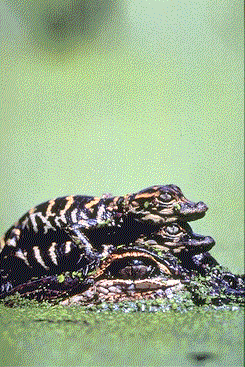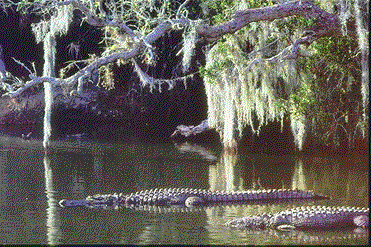
Reptiles
Reptiles in the Everglades
have colonized major habitats of the region, including terrestrial,
freshwater and marine environments. Their ability to survive without
a regular supply of drinking water exceeds that of amphibians and
is perhaps their most distinguishing characteristic from the closely
related amphibian family. The reptile’s independence from water
is most striking as it pertains to the reptilian egg: its hard shell
and internal organization allow for incubation away from water, unlike
amphibian eggs.
|

|
Because of the reptile’s tolerances for salt
water as well as drought, reptiles hold a superior potential over amphibians
for crossing geographic barriers. However, terrestrial and freshwater reptiles
are still constrained by relatively small expanses of marine habitat. As a result,
most of the non-marine reptiles of the Everglades are, in fact, native to the
temperate landmass of North America.
Common or well-known reptiles of the Everglades
region include two species of crocodilians, eleven species of turtles, three
species of lizards, and sixteen species of snakes.
 |
Alligators
|
One reptile has stood as the prominent representative
of Everglades wildlife over the years, the American alligator. Alligators have
faced a rough history in the Everglades, as they were practically hunted to
extinction during the early 1900’s. After an impressive comeback since
the 1960’s, when they were placed on the endangered species list, their
population has increased to a sufficient number to support a controlled harvest
program.
Alligators, like most reptiles, build nests in which
to lay their eggs. Optimum nesting efforts are observed when water levels remain
stable or decrease throughout the nesting season (June-Sept). Significant nest
losses occur when the nests are submerged for about 48 hours.
Alligators serve an important ecological function
by maintaining "gator holes" or depressions in the mulch, which are
thought to provide a refuge for aquatic organisms as well as constitute a concentrated
food source for wading birds and other Everglades predators during drought.
The current alligator management program is designed
to conserve alligators and their habitat throughout the state of Florida by
establishing mechanisms that will provide economic incentives to public and
private interests. As direct benefactors of the resources, Floridians have a
vested interest in maintaining these wetlands in their natural conditions.
[Biology][Next]




